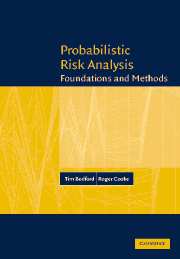Book contents
- Frontmatter
- Contents
- Illustrations
- Tables
- Preface
- Part I Introduction
- Part II Theoretical issues and background
- Part III System analysis and quantification
- 6 Fault and event trees
- 7 Fault trees – analysis
- 8 Dependent failures
- 9 Reliability data bases
- 10 Expert opinion
- 11 Human reliability
- 12 Software reliability
- Part IV Uncertainty modeling and risk measurement
- Bibliography
- Index
9 - Reliability data bases
from Part III - System analysis and quantification
Published online by Cambridge University Press: 05 June 2012
- Frontmatter
- Contents
- Illustrations
- Tables
- Preface
- Part I Introduction
- Part II Theoretical issues and background
- Part III System analysis and quantification
- 6 Fault and event trees
- 7 Fault trees – analysis
- 8 Dependent failures
- 9 Reliability data bases
- 10 Expert opinion
- 11 Human reliability
- 12 Software reliability
- Part IV Uncertainty modeling and risk measurement
- Bibliography
- Index
Summary
Introduction
Reliability data is not simply ‘there’ waiting to be gathered. A failure rate is not an intrinsic property of a component like mass or charge. Rather, reliability parameters characterize populations that emerge from complex interactions of components, operating environments and maintenance regimes. This chapter presents mathematical tools for defining and analyzing populations from which reliability data is to be gathered. This chapter is long, the reason being that the mathematical sophistication required by a practicing risk/reliability analyst has increased significantly in the last years. Whereas in the past the choices of statistical populations and analytic methods were hard wired with the design of the data collection facility, today the analyst must play an increasingly active role in defining statistical populations relative to his/her particular needs.
The first step is to become clear about why we want reliability data. Modern reliability data banks (RDBs) are intended to serve at least three types of users: (1) the maintenance engineer interested in measuring and optimizing maintenance performance, (2) the component designer interested in optimizing component performance, and (3) the risk/reliability analyst wishing to predict reliability of complex systems in which the component operates.
To serve these users modern RDBs distinguish up to ten failure modes, often grouped into critical failures, degraded failures and incipient failures. Degraded and incipient failures are often associated with preventive maintenance. Whereas critical failures are of primary interest in risk and reliability calculations, a maintenance engineer is also interested in degraded and incipient failures.
- Type
- Chapter
- Information
- Probabilistic Risk AnalysisFoundations and Methods, pp. 153 - 190Publisher: Cambridge University PressPrint publication year: 2001

